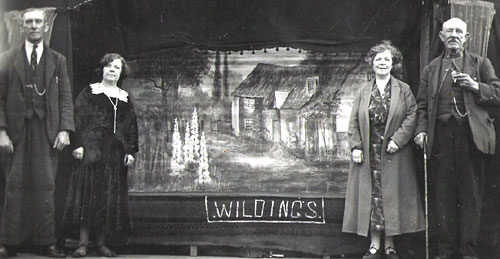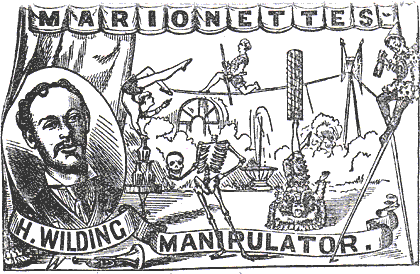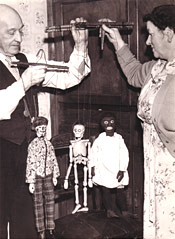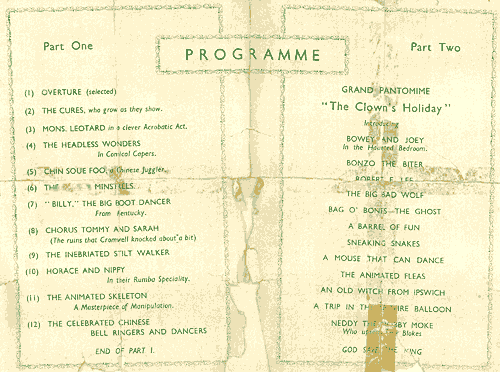HARRY
|
|
|||||
|
1914 saw the beginning of the end for Wilding's Touring Show, as five of his sons were called up to serve their Country. Harry made an attempt to continue, but the shows were too elaborate to be presented without the assistance of his large family and eventually, he was forced to close the show down. He settled, for the last thirty or so years of his life in the Cannock Chase area, in Chadsmoor, between Cannock and Hednesford to be exact, where he continued to live in his converted touring wagons and ended his working life in the Cannock Chase Coal Mines. All his sons miraculously survived the First World War, with only one - John Wilding - being wounded at the Battle of Loos. However, when they returned from War, interest in puppetry had waned and the sons' only option was to join their Father working in the Coal Mines - the area's main employer.
Harry did return briefly to puppetry in his late 70s, assisting his son Bert, who toured the show again for a few years with limited success. According to his son Bert, Harry continued to make puppets and remained a skilled manipulator. In an interview published in the 'World's Fair' on 13th October 1934, Harry commented "I have made all my own figures for years, painted and designed all my own scenery, written scores of plays and sketches, dressed all my little actors and actresses and played the cornet in my own band." Harry Wilding died at his home
in Moreton Street, Chadsmoor, in 1941, aged 84. |
Two Little Vagabonds
Due to the Wildings' vast repertoire, they were able to stay in many towns for a considerable time. Sometimes presenting six different plays a week.
|
|||||
|
HARRY WILDING'S CHAMPION MARIONETTE THEATRE The Entertainment is manipulated by the Wilding Family only. These Marionettes are on a scale equal to life. They move and apparently speak with a facility equal to human beings. The entertainment is essentially different from theatricals; the characters in the plays are represented by miniature marionettes. The Proprietor wishes to impress upon the minds of the public that he intends to bring forward such a class of entertainment that cannot fail to please. All such abundance of sensational novelties and mechanical skill that have never been witnessed in any other travelling exhibition of the kind. THE PERFORMANCES ARE STRICTLY MORAL AND
INSTRUCTIVE AND CALCULATED TO PLEASE ALL CLASSES |
||||||
|
The Entertainment will Terminate Each Evening with a Screaming Farce PEOPLE'S POPULAR PRICES Agent in Advance: Mr Harry Wilding Jnr. Stage Manager: Mr James Wilding Acting Manager: Mr Herbert Wilding Wardrobe Mistress: Mrs L. Wilding Proprietor: Mr Harry Wilding Researched from Articles Published in "The World's Fair" |
||||||
 Right: Harry Wilding and Puppeteer Mary L Williams (nee Fanning) Left: Bert Wilding & His Wife Tottie (Mary's Twin Sister) in front of the Marionette Stage
|
||||||
| HARRY WILDING PAGE 2 >>> | ||||||





